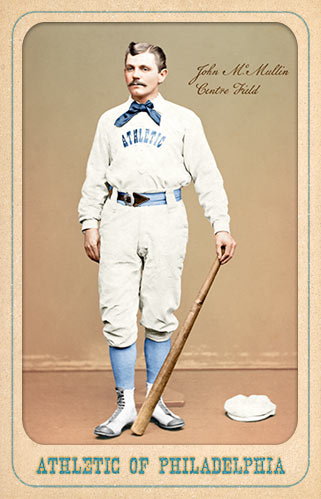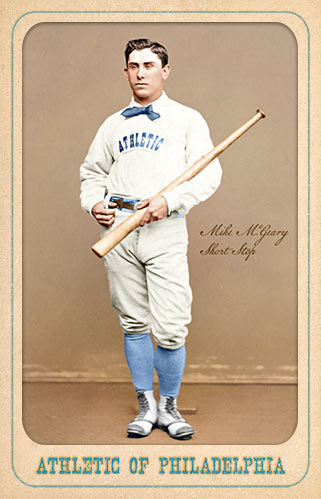
- Series: Athletic of Philadelphia: 1874
- City: Philadelphia
- Team: Athletics (NAPBBP)
- League: National Association (NAPBBP)
This cabinet is currently on the drawing board and is coming soon.
John Phillips Jenkins Sensenderfer (1847-1903) was a second baseman and outfielder for the Philadelphia Athletics during the first four years of the National Association of Professional Base Ball Players, from 1871-74. The debonair man with an aura of aristocracy earned his nickname at least in part from the elegant mustache he sported. The Count, a lifelong Philadelphian, had been with the club in the amateur league since 1866, making him one of the true leading lights of baseball’s earliest days. Sensenderfer hit .299 over his ML career, but injuries prevented him from approaching the outstanding batting he displayed in the Athletics’ early days in the NABBP. For example, he scored over 200 runs in 1868 as one of the most prolific of early hitters.
- After leaving baseball, Sensenderfer turned to politics. He was a local county commissioner and active in state Democratic roles as well

- Series: Athletic of Philadelphia: 1874
- City: Philadelphia
- Team: Athletics (NAPBBP)
- League: National Association (NAPBBP)
This cabinet is currently on the drawing board and is coming soon.
Alfred James Reach (1840-1928) “served baseball with distinction as player, organizer, club owner and provider of the equipment to attain the highest possible skill in the game,” per his own Reach’s Official Base Ball Guide upon his death. “A good man, of the kindest impulses, his name will last as long as we have baseball” expressed the legacy of one of the great men of the early era of America’s game. The London-born, Brooklyn-raised Reach joked that he made the gloves he eschewed in the beginnings of the game in which he starred for the Brooklyn Eckfords and Philadelphia Athletics. He also made the AL’s balls while owning the NL Phillies franchise. A genius for marketing equipment and a lifelong love of the game made him one of the most influential figures of baseball’s first half-century.
- Began play in the amateur era and was a stalwart of the NABBP, first with the Brooklyn Eckfords from 1861-1864, then with the old Athletics of Philadelphia, from 1865-1870
- Made the transition with the Athletics from the NABBP to the NAPBBP in 1871, helping the team win the first professional baseball pennant that year
- Retired from play with the demise of the NAPBBP after the 1875 season
- Founded the NL’s Philadelphia club in 1883, still going strong today as the Philadelphia Phillies
- Built the first modern ballpark in 1887, then rebuilt it with steel after a fire in ‘94
- Al's brother Bob Reach was an MLB shortstop for 3 games, 1872-1873
- Was the 80th player to debut in MLB

- Series: Athletic of Philadelphia: 1874
- City: Philadelphia
- Team: Athletics (NAPBBP)
- League: National Association (NAPBBP)
- Hall: J.G. Taylor Spink Award Recipient
Timothy Hayes Murnane (1851-1917) vaulted from a career in the early days of the game to become the noted baseball writer for the Boston Globe for three decades. As a player, Murnane had occasional success, but remained less than full time. He did place fifth in the National Association in 1872 with a .359 average for the Middletown (CT) Mansfields. He was in Philadelphia with the Athletics and White Stockings for the final years of pre-modern baseball in the NA before joining the Boston Red Caps (Beaneaters) in the inaugural season of the National League, 1876, and won a pennant the following year. Murnane’s incisive grasp of the game would manifest in a varied career as field manager, executive, owner and minor league president over the ensuing decades. But it was with the pen rather than the bat that Murnane made his greatest mark. In 1946, the Hall of Fame established the Honor Rolls of Baseball to recognize non-player contributions and Murnane was among a dozen scribes enrolled. Murnane was the 1978 recipient of the J.G. Taylor Spink Award commemorating outstanding achievement by the Baseball Writers’ Association of America.
- In his eight-year career as player, Murnane averaged .261. His final season was as player/manager for the Union Association’s Boston Reds as they tried vainly to challenge the NL
- Recipient of the J.G. Taylor Spink Award: 1978

- Series: Athletic of Philadelphia: 1874
- City: Philadelphia
- Team: Athletics (NAPBBP)
- League: National Association (NAPBBP)
John F. McMullin (1849-1881) began amateur ball with his hometown Keystones of Philadelphia in 1867 as an outfielder. He moved to the Buckeye of Cincinnati in ‘68 and the Haymakers of Troy in ‘70, with whom he joined the first openly professional league in 1871. He pitched for Troy his first season when the only other southpaw hurler in the NABBP was Charlie Pabor of the Union of Morrisania (who is more renowned for his nickname, The Old Woman in the Red Cap, than for his mound prowess). McMullin also pitched some for the National Association's Troy entry in ‘71, and is the only known lefty to pitch regularly that year. He served as an emergency pitcher in two games across the 1872 and ‘73 campaigns, but played primarily in the outfield the rest of his career. He always had respectable years at the plate, including his final season with the Philadelphia White Stockings in 1875 where he hit .257. His best year had been with the Athletics in 1874, leading the team with 90 hits and a .346 average.
After being a pioneering member of baseball's first two organized leagues and playing nearly all of his teams' games in the five year history of the National Association, McMullin never played a single game in the National League that replaced it. It is not known why McMullin’s tenure in baseball ended so abruptly on the eve of the modern major leagues and he would die a few short years later at age 32 in his native Philadelphia.
- In 1877, McMullin appeared as one of three managers of a Philadelphia entry in the League Alliance, a loose consortium of teams in the Northeast that formed as a response to the new NL
- Like teammate Mike McGeary, McMullen [sic] appears on an 1871 Burr Pennfield Troy Haymaker Scorecard. Inspired by and rarer than the Mort Rogers' Scorecards, such "photographic picture cards" were important precursors to the modern baseball card


- Series: Athletic of Philadelphia: 1874
- City: Philadelphia
- Team: Athletics (NAPBBP)
- League: National Association (NAPBBP)
Michael Henry McGeary (1851-1933) was, per Sporting Life in 1905, “the best runner in his profession,” due largely because he was “the one player who regularly practiced sliding.” McGeary was also nearly impossible to strikeout. From 1871-76, McGeary fanned only six times in 1,518 plate appearances.
Mike began in pro ball with the Troy Haymakers in ‘70 and stayed with the team as it became a founding member of the National Association the next season. Usually an infielder, Mike was the shortstop for the Philadelphia Athletics when Al Spalding led his Boston club and the A’s on a tour of Britain and Ireland in the summer of 1874. Designed by Harry Wright to promote the game in Europe, the expensive effort failed to generate interest.
McGeary joined the new NL with the St. Louis Browns in 1876 during the era when gambling was rife and William Hulbert was bent on reform. Long-suspected of throwing games, McGeary was the first NL player accused. Suspended and reinstated due to a lack of evidence, Mike continued to generate rumors and suspicion but escaped sanctions and completed over a decade in the game.
- Sporting Life in 1888 described the yellow “parasol” captain McGeary used to signal to the bettors in the grandstands. In one 1875 game, Mike made five of his Philadelphia White Stockings’ 21 errors in a loss to Chicago, reportedly earning each Philadelphia player between $300-$500 from the gamblers.
- From 1871-1875, McGeary averaged 1.22 runs per game, scoring 305 runs in 250 games
- Over his career, McGeary struck out just 60 times in 2,507 plate appearances
- One of the most prominent players of the era, Mike appears on an 1871 Burr Pennfield Troy Haymaker Scorecard. Inspired by and rarer than the Mort Rogers' Scorecards, such "photographic picture cards" were important precursors to the modern baseball card






